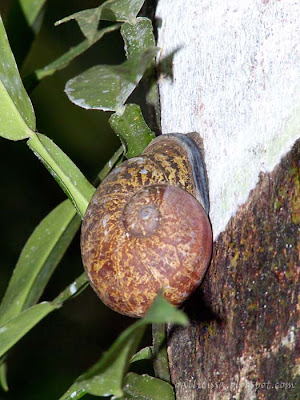The sun was still struggling to appear through the thick carpet of grey clouds when we made our first leg stretch. We were on the way to Sinharaja rain forest. My client was Steve Lane—a keen British birder. With memberships in the British dragonfly society and the British butterfly conservation society, Steve was actually a bit of an all-round naturalist. He had arrived the day before and was based in the luxurious Blue Water Hotel in Wadduwa in the west coast when I picked him up.
On the way to Sinharaja we made a series of wayside stops. This was done just in case we run into 'rain forest weather', as the skies were gloomy. In such conditions, birding can prove tough, especially inside the forest. Our strategic roadside stops brought us some good birds namely, Layard’s Parakeet, Sri Lanka Hanging Parrot, White-browed Bulbul, Small Minivet, Orange Minivet, Crested Treeswift, Indian Swiftlet, Indian Robin, Yellow-billed Babbler, Southern Coucal, Long-billed Sunbird, Purple-rumped Sunbird, Brown-headed Barbet, Yellow-fronted Barbet, Sri Lanka Green Pigeon, Jerdon's Leafbird, Black-hooded Oriole, Green Imperiel Pigeon, Black-rumped Flameback, Crested Serpent Eagle, Crested Hawk Eagle.
All of these ensured that we met our RDA (recommended daily allowance) of birds even before reaching the ticket office of the forest.
Our jeep driver Ranji was awaiting our arrival at the ticket office, and soon after obtaining our permits and meeting our mandatory local guide, Dharshana, we drove up to Martin’s for a quick cuppa. Just as I experienced on the previous trip, the forest was absolutely teeming with life. I think the heavy rains we had in the last several days had helped. Despite the early signs of gloomy conditions, the weather held up when it mattered, and we didn't have to use our brollies even on a single occasion.
On bigger tours we can have luxury of taking this easy as often we have multiple chances to see thing during the course of the trip. However, on day tours, we do not have that freedom, so I try to show things to my clients on the first opportunity itself. This worked well on this trip too. To give you a classic example, soon after entering the forest, we heard a Sri Lanka Blue Magpie at the back. It was tempting ignore it, hoping that we will encounter it later on during the walk. But, I decided go for it. And it turned out to be a good call as the sighting we had of it proved the only one for the whole trip. It was also Steve's top highlight of the trip, which made the decision to go for it all the more special.
So here's my Donald Trump like big statement:
Never put off things on day tours—there may be no second chance!
We were extremely lucky to encounter three full-blown mixed-species bird flocks, which afforded exceptional views of all our flock-associated targets in quick order. The first of this was had near the very hotspot we encountered the flock in making emma happy part 2. As in that occasion, we ran into minimal pains and the birds observed in this feeding frenzy included Orange-billed Babbler, Sri Lanka Crested Drongo, Malabar Trogon, Red-faced Malkoha, Velvet-fronted Nuthatch, Bar-winged Flycatcher-shrike, Dark-fronted Babbler, Square-tailed Black, Yellow-browed Bulbul, Black-capped Bulbul, Common Iora, Legge’s Flowerpecker, Orange Minivet, and Black-naped Monarch.
Soon after the flock activity subsided, a pair of ultra-elusive Green-billed Coucals obliged to give jaw-dropping views in the scope. I was able to quickly capture my best record shot of this scarce endemic. This was my top highlight of the trip.
Our second flock was observed close to the spot we had our flock in MEH Part 1, and it had, among other things, a pair of Sri Lanka Scimitar Babblers. A Brown-capped Babbler was seen briefly by me but eluded Steve. One of the highlights of this flock was a stunning Malabar Trogon male, which waited long enough to offer prolonged views in the scope, and the digiscoped photo on top right.
This juvenile Legge’s Flowerpecker was safely placed in a mesh of branches that would have proved tough for an Accipiter to get at. It was awaiting parental attention.

Our other birding highlights included Sri Lanka Junglefowl, White-faced Starling, Sri Lanka Myna, and Emerald Dove. After a late lunch and a cuppa, we returned to the Blue Water Hotel by 7.30 p.m. On the way back, Steve braved to try Pol-roti with improvised-explosive Lunu-miris. Lunu miris is a chillie paste made with (a choice of) chillies and onionons; adding lime in the end. This version was made with Thai pepper. Putting them to his mouth, and after regaining his breath, Steve told me that it was the hottest thing ever tasted!
Non-birding highlights
Mammals:
Purple-faced Leaf Monkey Trachypithecus vetulus—a troop of this endemic folivorous primate afforded good views.
Layard’s Squirrel Funambulus sublineatus—in mixed species bird flocks as they usually do.
Giant Squirrel Ratufa macroura—following birds in the second flock encountered.
Butterflies:
Common Imperiel Cheritra freja—not a common species in Sri Lanka as the name suggests. We had brief but good views of this lycaenid butterfly sporting a long tail, which was a first for me at Sinharaja.

Blue Admiral Kaniska canace—we had good long looks of an individual settled on a broken concrete bridge. This again was my first sighting of this striking blue butterfly at Sinharaja.
In addition to the above, we had Red Helan, Cruiser (both sexes), Clipper, Sri Lanka Rose, Giant Crow, Tailed Jay, Bluebottle, Blue Glassy Tiger, Common Glassy Tiger, Plum Judy, and Glade-eye Bushbrown.
Dragonflies:
Newly-discovered Lyriothemis sp.—we had good looks of this rain forest dragonfly, which awaits formal description. Here is the female.

Fruhstorfer’s Junglewatcher Hylaeothemis fruhstorferi fruhstorferi—we encountered this highly scarce endemic on several occasions including a pair close together.

In addition to the above, we had a few of the usual suspects including Shining Gossamerwing, Spine-tufted Skimmer, Black-tipped Flashwing, Marsh Skimmer and Green Skimmer (in tandem), and Blurry Forestdamsel.
Reptiles:
Sri Lanka Whistling Lizard Calotes liolepis—we had two encounters of this rare endemic agamid lizard. The one was when it was found on a lichen-covered wall to which it was merged well as shown here.

Green Forest Lizard Calotes calote—this young male wearing a fresh coat of skin looked to be at the prime of its youth.

Other reptiles seen were Common Skink, Kangaroo Lizard, and Sri Lanka Keelbacked Water Snake.


























































